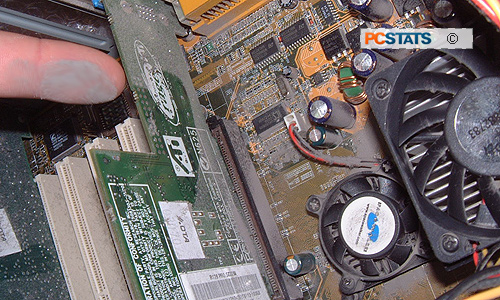Static electricity,
while not necessarily the constant danger to components that it is sometimes presented
as, can still be a real threat to your system if you
decide to start rubbing fabric over your motherboard to clean it. The same things
goes with vacuuming. Just think, a plastic or rubber hose, static generated by the belt or motor, powerful
suction. All of these spell possible disaster for your
PC.
The safest
way to spring clean the inside of your case is with a can of compressed air from
your local computer, electronics or hardware store. Here's the
procedure.
Assuming no fans need servicing,
as covered above, carefully remove the CPU fan and heatsink. Using the compressed
air, blow any standing dust from in-between the blades of the heatsink. Replace
the heatsink.
For the next step, it's best to have the
computer outside, or in an area that can be easily vacuumed afterwards, as
cleaning with compressed air can generate a lot of loose dust and assorted
airborne gunk.
Thoroughly clean the inside
of the computer of all visible standing dust using the compressed air. Be sure
to hold the can as close to vertical as possible to prevent unnecessary liquid
spray. This is unlikely to harm your components though.

Be aware of your health
too, since when you first let loose with the compressed air, you are going to
create a huge cloud of nastiness which you want to avoid breathing in. Goggles
might be a good idea here too. Generally speaking, you are simply trying to
remove as much of the visible dust as possible.
Once you are finished,
there's a neat little experiment you can pull with the rest of that compressed air
can.... but nah.... you wouldn't be interested in that. ;-)
Once your computer is cleaned out and the fans
seen to, there are a few other things you can and should do to help
make the future a cleaner, brighter place for your system.
While you have your case open, it is also a
good time to give the motherboard a close inspection for blown or leaking
motherboard electrolytic capacitors. The tops of capacitors on some older
motherboards may be domed, indicating a buildup of gas inside, or show signs of
some brown liquid that has leaked out at the base of the capacitor. You can find
more information on this issue here if needed.
Preventative maintenance
First of all, if your
computer is on the floor under the desk, move it if at all possible. As
stated before, "the higher the better" when it comes to keeping your computer clean. Next, give
the inside of your computer a quick once over to make sure
all components and connections are firmly and correctly attached.
Once you have
assured yourself that everything is where it should be, it might be time to think
about neatening your system up, especially the wiring. Good airflow is essential in a modern PC,
and in addition to case fans, rearranging the wiring in your system
can substantially improve airflow and prevent dust from settling.
Bundling your cables also has the side benefit of assuring that a stray wire is
not going to foul up your heatsink fan at some point. Nothing especially complex
needs to be done with this, just some plastic ties to bundle loose wire out of
the way of the airflow. Drive cables, while too thick to be bundled, can be
safely folded over themselves, or tucked out of the way in a free drive bay. If
you are feeling especially decorative, cable tubes or even rounded drive cables
should be readily available from your local computer store.

